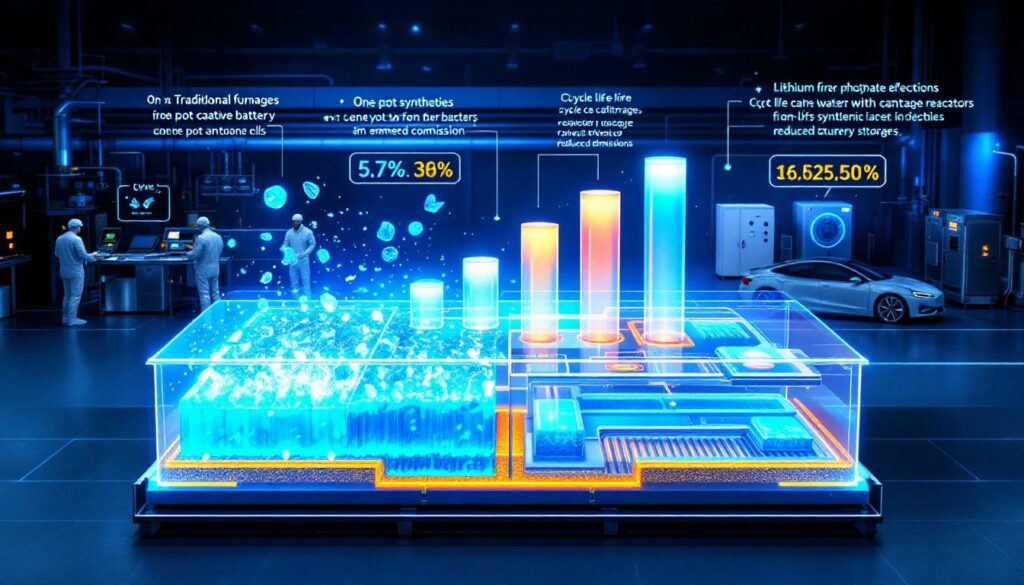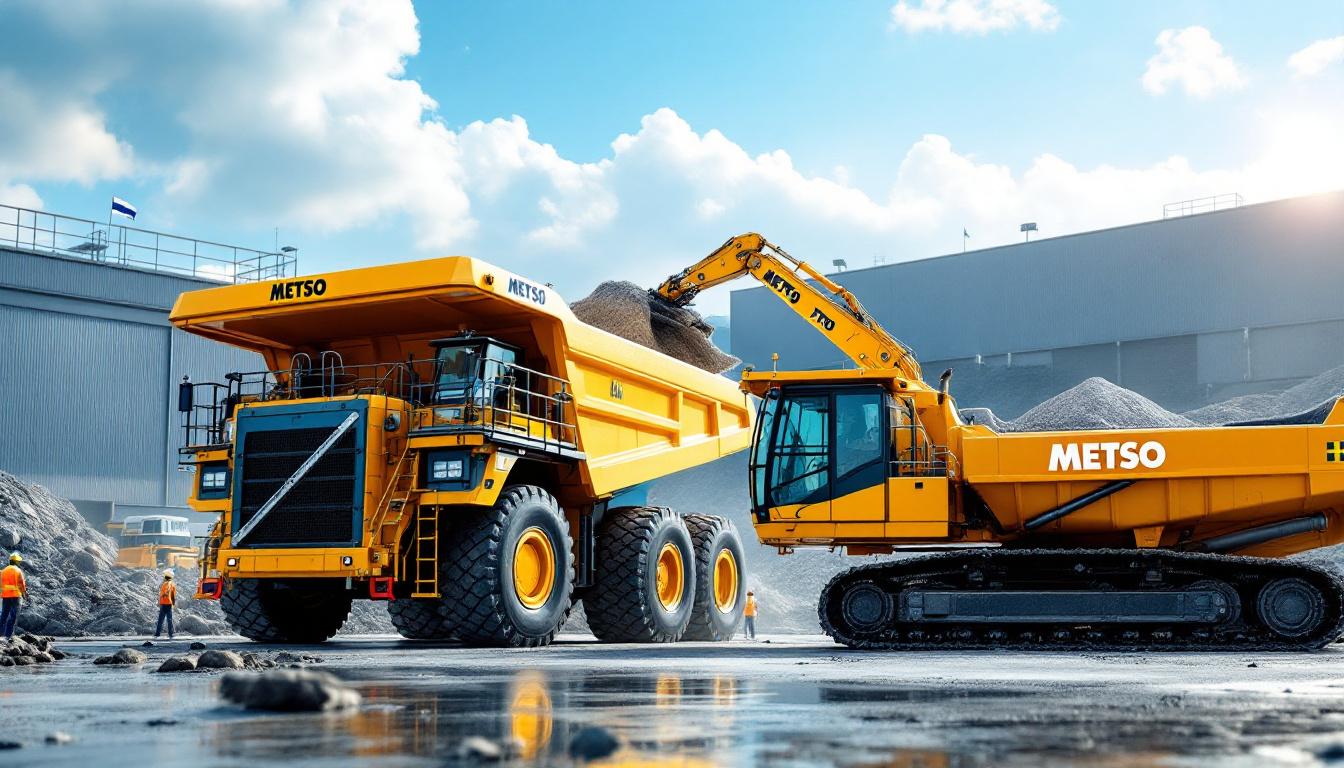What is Lithium Iron Phosphate (LFP) Battery Technology?
Lithium Iron Phosphate (LFP) batteries represent one of the most promising cathode chemistries in the lithium-ion battery market. Unlike other lithium-ion variants, LFP batteries utilize iron phosphate as the cathode material, creating a more stable, safer, and cost-effective energy storage solution.
The chemistry consists of lithium ions, iron, and phosphate in a specific crystalline structure that enables excellent thermal stability and longer cycle life compared to other lithium-ion chemistries. This unique structure prevents oxygen release during thermal runaway scenarios, making LFP batteries inherently safer than nickel-based alternatives.
"Our technology simplifies the process, drives down the capital intensity, the operating intensity, the energy intensity, and the water intensity of lithium iron phosphate production," explains Dan Blondell, CEO of Nano One Materials, highlighting the core advantages of advanced LFP manufacturing.
LFP batteries excel in several key performance areas:
- Superior safety profile with exceptional thermal stability
- Extended cycle life (typically 2,000-4,000 cycles vs 1,000-2,000 for NMC)
- Lower cost (approximately 30-40% less expensive than nickel-based chemistries)
- Cobalt-free composition, eliminating ethical supply chain concerns
- Excellent load performance suitable for high-power applications
Understanding LFP Chemistry and Applications
The fundamental chemistry of LFP involves lithium ions shuttling between a graphite anode and an iron phosphate cathode during charge and discharge cycles. This olivine structure provides remarkable stability but comes with a trade-off of lower energy density compared to nickel-manganese-cobalt (NMC) or nickel-cobalt-aluminum (NCA) chemistries.
Despite the energy density limitation, LFP batteries have captured significant market share in applications where safety, longevity, and cost outweigh the need for maximum energy density:
Electric Vehicles: Many automakers, led by Chinese manufacturers and Tesla, have shifted to LFP batteries for standard-range models, appreciating the lower cost and superior safety profile. BYD's Blade Battery, a cell-to-pack LFP technology, has demonstrated how innovative engineering can overcome energy density limitations.
Stationary Energy Storage: Grid-scale installations and residential battery systems increasingly favor LFP chemistry due to its safety, longevity, and cost advantages. For applications where weight and volume constraints are less critical, LFP provides the ideal balance of performance and economics.
Defense and Critical Infrastructure: The thermal stability and safety of LFP batteries make them ideal for defense applications, emergency backup systems, and other critical infrastructure where reliability and safety cannot be compromised.
The Strategic Importance of LFP Production
The global demand for LFP batteries is projected to grow exponentially through 2030, driven by electric vehicle adoption and renewable energy integration. Industry analysts forecast LFP chemistry could capture up to 40% of the global lithium market insights by 2030, representing hundreds of gigawatt-hours of annual production.
This growth trajectory highlights several critical strategic considerations:
Supply Chain Vulnerabilities: Currently, over 90% of global LFP production capacity resides in China, creating significant geopolitical risks for Western nations transitioning to electrification. This concentration has prompted urgent efforts to develop domestic LFP manufacturing capabilities in North America and Europe.
"We're looking to break China's stranglehold on this supply chain by licensing our technology to many players," notes Blondell, emphasizing the geopolitical dimension of LFP production.
Economic Impact: As electric vehicles approach cost parity with internal combustion engines, the role of LFP batteries becomes increasingly significant. Their lower raw material costs and simpler supply chains provide a clear path to affordable electrification across multiple sectors.
Environmental Considerations: Beyond their operational advantages, advanced LFP manufacturing processes offer substantial environmental benefits compared to traditional methods, making them crucial for sustainable energy transition strategies.
How Does Traditional LFP Manufacturing Work?
The conventional production of lithium iron phosphate batteries has been dominated by Chinese manufacturers using processes that, while effective, present significant environmental and operational challenges. Understanding these traditional methods provides essential context for appreciating the innovations driving the industry forward.
Conventional Chinese Production Methods
Traditional LFP manufacturing begins with sourcing iron sulfate, typically as a byproduct from titanium oxide refining processes. This creates an immediate supply chain vulnerability, as the availability and quality of this precursor material depend on titanium production dynamics.
The multi-stage process typically involves:
- Precursor preparation: Converting iron sulfate into iron phosphate through chemical precipitation reactions
- Lithiation: Adding lithium hydroxide or carbonate through wet or dry mixing techniques
- Firing process: Extended heat treatment in tunnel furnaces (often called "pizza ovens") for 10-30 hours
- Post-processing: Grinding, particle sizing, and quality control steps
This approach faces several significant challenges:
Raw material inconsistency: The iron sulfate derived from titanium processing often contains variable levels of impurities and trace metals, requiring additional purification steps and affecting final product quality.
Process complexity: The multi-stage nature of traditional manufacturing necessitates numerous intermediate steps, each introducing potential quality variation and inefficiency.
Energy intensity: The extended firing times in conventional furnaces consume substantial energy, accounting for approximately 60% higher energy usage compared to newer methods.
"Traditional methods rely on iron sulfate tailings from titanium oxide refining, which can be dirty with trace metals," explains Blondell, highlighting the inherent quality challenges in conventional processes.
Environmental and Operational Challenges
The environmental footprint of traditional lithium iron phosphate battery production presents serious obstacles to scaling production, particularly in regions with strict environmental regulations:
Water consumption: Conventional processes require 80-100 cubic meters of water per ton of LFP produced, placing enormous pressure on local water resources, especially in water-stressed regions.
Wastewater management: The process generates significant volumes of wastewater containing sulfates and other chemicals that require specialized treatment before discharge.
Sulfate waste: The conversion from iron sulfate to iron phosphate produces sulfate-laden waste streams that present recycling challenges and potential environmental hazards.
Permitting hurdles: The substantial environmental impact of traditional manufacturing creates significant barriers to facility permitting in regions with stringent environmental regulations.
These environmental factors have effectively constrained LFP production expansion outside China, where environmental regulations have historically been less restrictive. For Western nations seeking to develop domestic battery supply chains, these challenges necessitate fundamentally different approaches to LFP production.
What Innovations Are Transforming LFP Production?
The limitations of traditional LFP manufacturing have driven significant innovation in production processes, with several breakthrough technologies poised to transform the industry. These innovations not only address environmental challenges but also offer substantial economic and strategic advantages.
One-Pot Synthesis Technology
One of the most promising advances in LFP production is the one-pot synthesis approach, which fundamentally reimagines the production process:
Direct chemical integration: Instead of sequential processing steps, one-pot synthesis combines lithium, iron oxide, and phosphoric acid in a single reactor vessel, enabling their direct chemical reaction into LFP.
Process simplification: By eliminating multiple intermediate steps, this approach dramatically reduces process complexity, equipment requirements, and potential quality variation points.
Reaction efficiency: The integrated reaction substantially cuts processing time compared to the 10-30 hours required in traditional methods, improving production throughput and energy efficiency.
Intellectual property landscape: This innovative approach is protected by extensive patent portfolios, with companies like Nano One Materials holding approximately 50 granted patents and 50 pending applications across major markets including the US, Canada, and China.
"We combine lithium, iron oxide, and phosphoric acid in one reactor, chemically reacting them into an entirely different compound," Blondell explains, describing the fundamental innovation behind one-pot synthesis.
The chemical reaction kinetics of one-pot synthesis offer several advantages over traditional methods:
- Controlled nucleation and growth: The direct reaction allows precise control over particle formation
- Reduced impurity introduction: Fewer processing steps mean fewer opportunities for contamination
- More consistent product: Homogeneous reaction conditions improve batch-to-batch consistency
Metal-to-Cathode (MtoCam) Processing
Another transformative innovation is Metal-to-Cathode (MtoCam) processing, which fundamentally changes the raw material requirements for LFP production:
Iron source diversification: Rather than relying on iron sulfate from titanium processing, MtoCam utilizes iron metal powders or oxides directly, eliminating a critical supply chain vulnerability.
Supply chain resilience: This approach enables sourcing iron from diverse suppliers globally, reducing dependency on Chinese iron sulfate sources.
Simplified processing: By bypassing the iron sulfate to iron phosphate conversion, MtoCam reduces process complexity and equipment requirements.
Strategic partnerships: Innovators in this space have established relationships with major iron producers like Rio Tinto to develop specialized iron powder specifications optimized for LFP production.
The direct utilization of iron metal or oxide powders offers significant advantages:
- Higher purity starting materials: Purpose-produced iron powders can meet strict purity specifications
- Process control: Consistent input materials enable more reliable manufacturing outcomes
- Regional supply chains: Iron powders can be sourced from diverse global locations
These innovations represent not merely incremental improvements but fundamental reimaginations of how LFP batteries are produced, enabling new production paradigms with far-reaching implications.
What Are the Economic Benefits of Advanced LFP Manufacturing?
The innovative approaches to LFP production deliver compelling economic advantages across the entire manufacturing value chain. These benefits transform the business case for LFP production, especially in regions previously challenged by traditional manufacturing economics.
Capital Expenditure Advantages
Advanced manufacturing processes dramatically reduce the upfront investment required to establish LFP production facilities:
Overall capital reduction: Innovative methods deliver approximately 30% lower capital costs compared to traditional approaches, significantly improving project economics and lowering barriers to entry.
Infrastructure simplification: The elimination of sulfation plants and wastewater treatment facilities removes major capital components from plant designs.
Engineering streamlining: Simplified processes require less complex plant engineering, reducing design costs and construction complexity.
Modular implementation: Advanced technologies enable modular, scalable plant designs that can be deployed incrementally, reducing initial capital requirements and financial risk.
Accelerated timelines: Simpler plant designs enable faster construction and commissioning, reducing the time from investment to production and improving overall project economics.
"Elimination of sulfation plants and wastewater treatment enables 'shrink-wrapped' plants that can be deployed anywhere," notes Blondell, highlighting how simplified infrastructure translates to capital savings.
The modular approach to plant design creates particular advantages for markets seeking to establish domestic production:
- Phased capacity expansion: Initial investments can be scaled up incrementally as demand grows
- Lower minimum economic scale: Viable production can begin at smaller capacities than traditional plants
- Location flexibility: Simplified environmental footprint expands potential facility locations
Operational Cost Improvements
Beyond capital advantages, advanced LFP manufacturing delivers significant operational cost benefits throughout the production lifecycle:
Overall operating expense reduction: Integrated processes deliver approximately 30% lower operating expenses compared to traditional methods, directly improving margins and competitiveness.
Water cost elimination: The 80% reduction in water consumption translates directly to lower utility costs and eliminated wastewater treatment expenses.
Energy savings: Energy efficiency gains of 60-80% substantially reduce one of the most significant operating costs in battery material production.
Labor optimization: Simplified operations require fewer personnel to manage and maintain, reducing workforce-related expenses.
Maintenance reduction: Less complex equipment configurations and fewer process steps translate to lower maintenance requirements and reduced downtime.
These operational advantages compound over the facility lifecycle, dramatically improving the total cost of ownership. For battery manufacturers and their customers, these savings ultimately translate to more competitive battery prices, accelerating the adoption of electric vehicles and energy storage systems.
How Does Modern LFP Production Impact Environmental Sustainability?
Beyond economic benefits, advanced LFP manufacturing processes deliver transformative environmental advantages that address the sustainability challenges of traditional methods. These improvements not only reduce environmental impact but also create strategic advantages for facility siting and regulatory compliance.
Carbon Footprint Reduction
Modern production techniques substantially reduce the environmental footprint of LFP manufacturing across multiple dimensions:
Greenhouse gas reduction: Advanced processes deliver approximately 60% lower greenhouse gas emissions compared to traditional methods, significantly improving the lifecycle carbon footprint of LFP batteries.
Wastewater elimination: The most innovative approaches achieve 100% reduction in wastewater discharge, removing one of the most significant environmental challenges of traditional production.
Energy efficiency: Lower energy intensity throughout the production process—approximately 60-80% less than conventional methods—reduces both direct and indirect carbon emissions.
Transportation optimization: Simplified supply chains and the ability to locate production closer to raw materials or customers reduce transportation-related emissions.
Lifecycle advantages: When considering the full environmental impact from raw material extraction through manufacturing, advanced processes demonstrate substantial improvements in lifecycle assessment metrics.
The environmental advantages of modern LFP production create compelling sustainability benefits beyond regulatory compliance:
- Improved ESG performance: Lower environmental impact supports corporate environmental, social, and governance objectives
- Sustainable supply chain: Reduced carbon intensity aligns with automotive and energy storage companies' decarbonization goals
- Circular economy potential: Simplified chemistry facilitates future recycling and material recovery
Permitting and Regulatory Advantages
The environmental improvements of advanced LFP production translate directly into regulatory and permitting benefits that can accelerate facility development:
Streamlined approvals: The minimal environmental impact of modern processes can significantly simplify and accelerate regulatory approval processes, particularly in jurisdictions with stringent environmental standards.
Discharge permit elimination: Plants with zero wastewater discharge avoid complex water discharge permitting requirements that often present major hurdles for traditional manufacturing.
Land use flexibility: Reduced environmental footprint expands potential facility locations, including sites that might be unsuitable for traditional manufacturing due to water discharge constraints.
Industrial zoning compatibility: The cleaner production profile of advanced LFP manufacturing allows facilities to operate within diverse industrial zones without special environmental accommodations.
"Permitting is much easier with no wastewater discharge, enabling siting close to battery plants or raw materials," explains Blondell, highlighting the strategic advantages of improved environmental performance.
These regulatory advantages can dramatically accelerate the development timeline for new production facilities, creating substantial competitive advantages in rapidly evolving markets.
What Does the Future LFP Manufacturing Landscape Look Like?
The technological innovations in LFP production are reshaping the industry's future, driving new models for manufacturing deployment and technology commercialization. These emerging paradigms promise to transform the global battery metals investment landscape.
Distributed Production Models
Advanced manufacturing technologies enable fundamentally different approaches to production deployment:
Modular plant architecture: Modern processes support smaller, modular plant designs that can be strategically located to optimize supply chain logistics and regional production needs.
Strategic geographic positioning: Simplified environmental requirements allow facilities to be placed in proximity to battery manufacturing operations, reducing transportation costs and supply chain complexity.
Regional supply chain development: Distributed production models enable the development of regional supply ecosystems, creating manufacturing clusters that support broader industrial development.
Logistics optimization: Localized production reduces transportation requirements, lowering both costs and carbon footprint throughout the supply chain.
Geopolitical resilience: Distributed manufacturing networks reduce vulnerability to trade restrictions, political tensions, and regional supply disruptions.
The benefits of distributed production extend beyond direct manufacturing considerations:
- Economic development: Smaller regional facilities can support broader industrial development in diverse locations
- Supply security: Multiple production sources enhance supply chain security for critical battery materials
- Tailored regional specifications: Local production can be optimized for specific regional customer requirements
Technology Licensing Strategies
The commercialization of advanced LFP production technologies increasingly leverages licensing models to accelerate global deployment:
Process design packages: Technology innovators are developing comprehensive process design packages that enable implementation across diverse geographical and operational contexts.
Intellectual property protection: Extensive patent portfolios protect core innovations while enabling controlled technology transfer through structured licensing arrangements.
Partnership models: Strategic collaborations between technology providers and established industrial operators combine innovative processes with manufacturing expertise.
Knowledge transfer frameworks: Comprehensive technical support and knowledge transfer programs ensure successful technology implementation across diverse operating environments.
Global scaling potential: Licensing approaches enable multiple simultaneous implementations, accelerating the global adoption of advanced manufacturing techniques.
"Licensing is key to breaking China's stranglehold on the supply chain. Collectively, multiple players will transform the industry," notes Blondell, highlighting the strategic importance of technology transfer.
These licensing strategies create mutual benefits for technology developers and manufacturers:
- Accelerated commercialization: Technology providers achieve faster market penetration than through direct manufacturing
- Reduced capital requirements: Licensing models require less capital from technology developers than building production facilities
- Manufacturing expertise leverage: Established industrial operators contribute production expertise to technology implementation
- Market-specific adaptation: Local manufacturers can adapt implementation to regional requirements and market conditions
How Can North America and Europe Develop LFP Supply Chains?
Establishing robust domestic LFP supply chains in Western nations requires strategic approaches to overcome China's current market dominance. The combination of technological innovation, policy support, and market development strategies provides a pathway to supply chain independence.
Breaking Dependency on Chinese Manufacturing
Developing alternative supply sources requires coordinated strategies across multiple dimensions:
Domestic raw material sourcing: Western nations are increasingly focusing on developing local sources of key materials, particularly iron powders that can replace Chinese iron sulfate in the supply chain.
Investment prioritization: Targeted investment in advanced manufacturing technologies that bypass traditional production constraints enables competitive Western production despite higher labor and regulatory costs.
Policy support frameworks: Government initiatives through funding programs, tax incentives, and regulatory support create enabling environments for
Want to Invest in the Next Major Mineral Discovery?
Discover significant ASX mineral discoveries as they happen with Discovery Alert's proprietary Discovery IQ model, which transforms complex mining data into actionable investment insights. Explore why historic discoveries can generate substantial returns by visiting Discovery Alert's dedicated discoveries page and begin your 30-day free trial today to position yourself ahead of the market.




